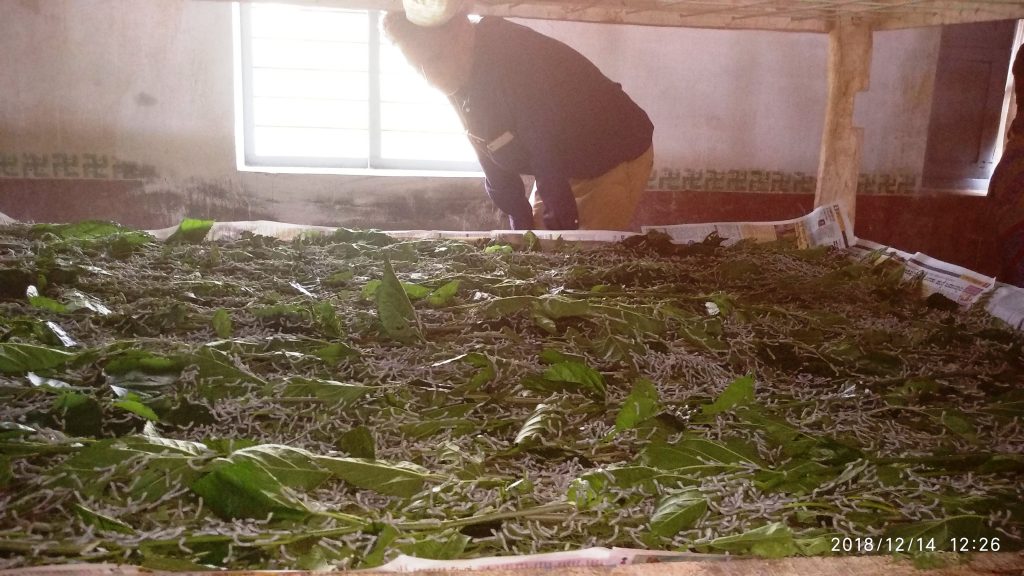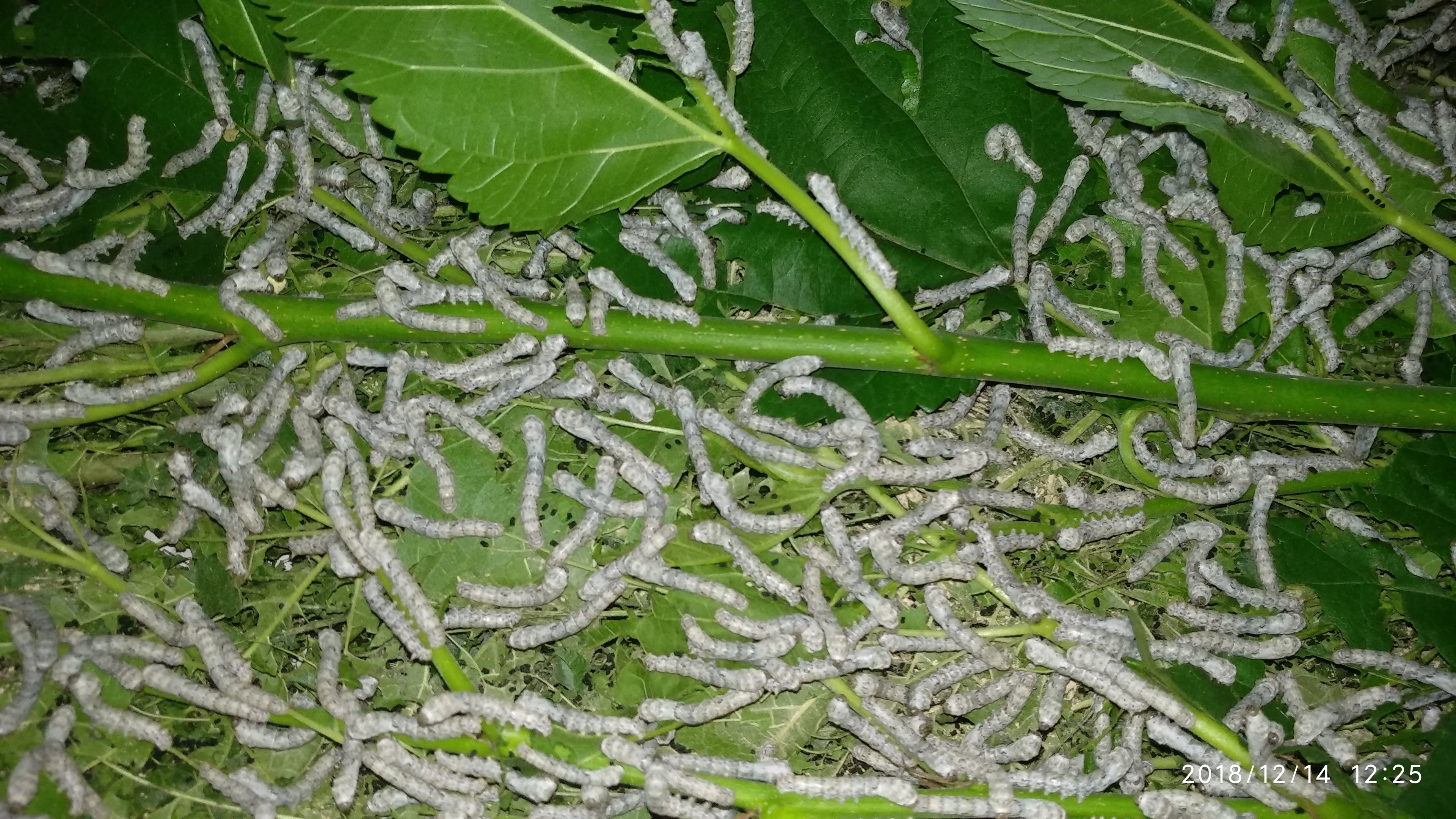India is the world’s second largest producer of silk. In Karnataka, the country’s largest silk-producing state, more than a million people earn their livelihood by making silk.One fine day ,we get opportunity to visit Sathnur village with six other meditation teachers.Here we have to conduct satsang in evening .So,we were roaming the villages street then encountered silkworms rearing in house
It all begins with mating. Chandana owns a family business of silk rearing in village near kanakpura, about 40kms from Bengaluru, runs a grainage, a facility that produces silkworm eggs. She has been in the business for 12 years and is well acquainted with the silkworm’s needs. “Silkworms are finicky creatures,” she tells me.
They thrive in warm, humid environments, but sicken if it is too warm or too humid.

After 5,000 years of domestication and breeding, the silkworm moth is the world’s only completely domesticated insect, wholly dependent on human help for survival. Due to captive breeding for so many years, its wings have reduced to small, ineffectual appendages that can flutter but don’t help it fly, not even to its mate.
At the grainage, they manually pair moths. On a sheet of paper marked with 40 circles are 40 small, plastic cups. Inside each cup are a male and a female silkworm moth. Two hours alone in the cup and the two are done mating.
Then they remove the male, which is smaller in appearance, from each cup, leaving the female inside. Around 48 hours later, the female moth begins laying eggs. When she is done, she dies. When the plastic cup is removed, each circle marked on the paper bears the female’s output: 400-500 eggs, each the size and shape of a pinhead. And so, with one death and many births, begins the story of silk.
The eggs hatch about eight days later, revealing caterpillars that resemble minuscule black threads, each about 3mm long. From now on, the silkworm has a single agenda—to eat.

Unlike wild silkworms, these domesticated caterpillars cannot move in search of leaves to feed on. Silkworms are fussy eaters and have a marked preference for the leaves of the mulberry tree
The newly hatched caterpillars are kept on large trays strewn with a generous layer of chopped mulberry leaves. At this stage, they loll about in air-conditioned comfort and are given only tender, young leaves, .
Caterpillars are far more sensitive to fluctuations in temperature and humidity than moths.

Like other caterpillars, silkworms go through five instars, which means they moult—or shed their skin—four times. Each time they moult, they emerge bigger and hungrier. Chandana rears silkworms only up to the second instar. So, to follow the young caterpillars’ progress through the silk trail, we visit Manohar, another family nearby.
Manohar and his family look after the caterpillars from the third instar. Next to his house, in a darkened building built especially for this purpose, Manohar has stacks of large bamboo trays lined with old but washed and disinfected saris. He spreads newspaper on these and then the silkworm’s chosen delicacy, mulberry leaves. One corner of the room has a huge pile of mulberry leaves, all of which will be consumed by his caterpillars in a day. The caterpillars need to be fed three times a day. “We feed them first and only then have our lunch,” says Manohar. By the end of the fifth instar, the caterpillar weighs about 10,000 times as much as it did when it was born.

Finally, some 28 days after the eggs hatch, the silkworm is ready for the next major stage in its life—metamorphosis. The caterpillars indicate this by going off their food. The farmers then carefully transfer each caterpillar on to a chandranki, a circular bamboo mount that is traditionally used for the silkworms to build their cocoons in.


It is fascinating to watch the caterpillars as they get ready to pupate. Each caterpillar moves its head restlessly, trying to find support to start its weaving. And then I notice a very fine, gossamer-like filament, seemingly made of light itself, trailing from a caterpillar’s mouth—silk!
Two-three days of constant spinning and weaving later, each caterpillar lies ensconced in a cocoon that looks like a pale yellow and fluffy blob smaller than my thumb. Two-three days later, the cocoons are taken to the market. By this time, as Manohar points out, each caterpillar has been handled at least thrice—once when it arrived, once when it was transferred to the chandranki and, finally, when the cocoon was removed from the chandranki to be sold.

Then they are sold at Comprising a series of cavernous halls, each filled with hundreds of large metal trays piled with cocoons, the market smells of cocoons and commerce. A knot of men moves through the maze of trays like a swarm of bees, stopping at each tray for fast and furious auction. Bids fly through the air. ₹ 320! ₹ 340! ₹ 360! for a kilo of cocoon!
The cocoons then move into the next stage of production, silk reeling.
. You can see these blue-shirted men cycling around town, bent under the weight of the huge bales of cocoons that they carry on their heads. Each bale weighs an astonishing 30-50kg.
The silkworms have led a cushy life till now, with their every need taken care of. Reeling is where it all comes to a gruesome end.
Shamshir works as a reeler, as does the rest of his family. Silk-reeling near Bengaluru happens mostly in small, cramped rooms attached to small, cramped houses. Men and women work in these dark, dingy, smoke- and steam-filled rooms for 8-10 hours a day, dipping their hands in scalding water. Essentially, the cocoons are dunked in boiling water, which allows the cocoon to be unravelled without breaking the silk fibre. When the silk has been reeled completely, what’s left is the pupa that was inside each cocoon, now dead.
For animal lovers, this is the abhorrent part of the silk-making process: The making of mulberry silk necessarily involves the killing of hundreds of silkworm larvae.
The last stop in the journey of silk is the weavers. There are power looms galore in and around Bengaluru, but the characteristic clickety-clack of handlooms can now only be heard at a handful of places on the outskirts of the city
Further there are hundreds of threads dangling from it, vertically, horizontally, everywhere. Parts of it move up and down rhythmically, operated by the weaver’s feet. Others slide from side to side in tandem with his hands. “You have to use all parts of your body to operate these,” smiles Ambareesh, who learnt the craft from his father.

It takes a day to set up the loom for a particular sari and one-three weeks to weave one. The end product of all this controlled chaos is perfection in the form of a silk sari.
Beginning with the people who bring male and female moths together, to those who tend to the mulberry plants, feed the caterpillars and enable their metamorphosis, to the men who bear the cocoons on their backs, to the reelers, who reel silk while inhaling smoke and steam and, finally, the weavers who patiently weave the silken magic, we have come to the culmination of the silk trail—six yards of regal splendour.



19 replies on “Ravenous 6 yards Silk saree in making”
You actually make it seem so easy with your presentation but I find this matterto be really something which I think I would never understand.It seems too complicated and extremely broad for me. I am looking forward for your next post,I’ll try to get the hang of it!
Your reply and support will always be remembered, fondly in good times, and as encouragement in bad.
Thanks for appreciation ,
We are also in learning phase.
Working on WordPress here.
I was aware about the hard work involved in making the silk saree. But the process explanation in the blog is so lucid.
The only sad part is where the worm dies.
Thanks for reviewing !
(The only sad part is where the worm dies.)
We all play our piece of role in greater good at least Himanshu Singh take time to remember them .
Hi everybody, here every person is sharing these kinds
of experience, therefore it’s good to read this blog,
and I used to go to see this web site daily.
First off I would like to say superb blog! I had a quick question which I’d like to ask if you don’t mind.
I was interested to know how you center yourself and clear your
mind before writing. I have had difficulty clearing my thoughts in getting my ideas
out there. I truly do enjoy writing however it just seems like the first 10
to 15 minutes are generally lost simply just trying to figure out how to begin. Any ideas or tips?
Kudos!
Thanks For your efforts !
Great weblog here! Additionally your web site lots up fast!
What host are you using? Can I get your affiliate link to your host?
I want my web site loaded up as quickly as yours.
After research a couple of of the blog posts in your website now, and I really like your way of blogging. I bookmarked it to my bookmark web site list and will probably be checking back soon. Pls check out my web page as well and let me know what you think.
Amazing blog layout here. Was it hard creating a nice looking website like this?
Can I just say what a reduction to seek out somebody who truly is aware of what theyre talking about on the internet. You positively know how you can carry a problem to light and make it important. More folks must learn this and understand this facet of the story. I cant imagine youre no more well-liked because you undoubtedly have the gift.
Amazing blog layout here. Was it hard creating a nice looking website like this?
Thanks-a-mundo for the blog.Really looking forward to read more. Awesome.
I just want to mention I’m all new to blogs and certainly savored you’re web site. More than likely I’m want to bookmark your site . You surely have good writings. Appreciate it for sharing your web page.
I wish to show my gratitude for your kindness for individuals that require guidance on this one subject matter. Your very own dedication to getting the message all around appears to be really good and has in every case empowered ladies much like me to realize their objectives. Your personal invaluable help and advice indicates much to me and somewhat more to my colleagues. Thanks a lot; from all of us.
I just want to mention I’m all new to blogs and certainly savored you’re web site. More than likely I’m want to bookmark your site . You surely have good writings. Appreciate it for sharing your web page.
Hi” best wishes to you and your very nice blog”
thank you web site admin